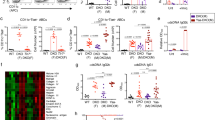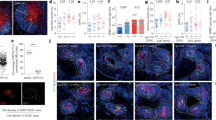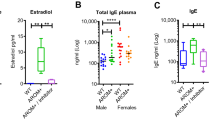Abstract
Most systemic autoimmune diseases occur more frequently in females than in males. This is particularly evident in Sjögren’s syndrome, systemic lupus erythromatosis (SLE) and thyroid autoimmunity, where the ratio of females to males ranges from 20:1 to 8:1. Our understanding of the etiology of SLE implies important roles for genetics, environmental factors and sex hormones, but the relative significance of each remains unknown. Using the New Zealand hybrid mouse model system of SLE, we present here a new fetal liver chimera-based system in which we can segregate effects of immune system genes from that of sex hormones in vivo. We show that female hematopoietic cells express an intrinsic capacity to drive lupus-like disease in both male and female recipient mice, suggesting that this capacity is hormone independent. Particularly, only chimeric mice with a female hematopoietic system showed significantly increased numbers of germinal center B cells, memory B cells and plasma cells followed by a spontaneous loss of tolerance to nuclear components and hence elevated serum antinuclear autoantibodies. A protective effect of testosterone was noted with regard to disease onset, but not disease incidence. Thus, genetic factors encoded within the female hematopoietic system can effectively drive lupus-like disease even in male recipients.
This is a preview of subscription content, access via your institution
Access options
Subscribe to this journal
Receive 6 digital issues and online access to articles
$119.00 per year
only $19.83 per issue
Buy this article
- Purchase on Springer Link
- Instant access to full article PDF
Prices may be subject to local taxes which are calculated during checkout





Similar content being viewed by others
References
Whitacre CC . Sex differences in autoimmune disease. Nat Immunol 2001; 2: 777–780.
Mellors RC . Autoimmune and immunoproliferative diseases of NZB/Bl mice and hybrids. Int Rev Exp Pathol 1966; 5: 217–252.
Gubbels Bupp MR, Jorgensen TN, Kotzin BL . Identification of candidate genes that influence sex hormone-dependent disease phenotypes in mouse lupus. Genes Immun 2008; 9: 47–56.
Helyer BJ, Howie JB . Renal disease associated with positive lupus erythematosus tests in a cross-bred strain of mice. Nature 1963; 197: 197.
Morton JI, Siegel BV, Moore RD . Transplantation of autoimmune potential. II. Glomerulonephritis in lethally irradiated DBA/2 recipients of NZB bone marrow cells. Transplantation 1975; 19: 464–469.
Roubinian JR, Talal N, Greenspan JS, Goodman JR, Siiteri PK . Effect of castration and sex hormone treatment on survival, anti- nucleic acid antibodies, and glomerulonephritis in NZB/NZW F1 mice. J Exp Med 1978; 147: 1568–1583.
Roubinian J, Talal N, Siiteri PK, Sadakian JA . Sex hormone modulation of autoimmunity in NZB/NZW mice. Arthritis Rheum 1979; 22: 1162–1169.
Roubinian JR, Papoian R, Talal N . Androgenic hormones modulate autoantibody responses and improve survival in murine lupus. J Clin Invest 1977; 59: 1066–1070.
Wu WM, Lin BF, Su YC, Suen JL, Chiang BL . Tamoxifen decreases renal inflammation and alleviates disease severity in autoimmune NZB/W F1 mice. Scand J Immunol 2000; 52: 393–400.
Talal N, Ahmed SA, Dauphinee M . Hormonal approaches to immunotherapy of autoimmune disease. Ann NY Acad Sci 1986; 475: 320–328.
Murphy ED, Roths JBA . Y chromosome associated factor in strain BXSB producing accelerated autoimmunity and lymphoproliferation. Arthritis Rheum 1979; 22: 1188–1194.
Subramanian S, Tus K, Li QZ, Wang A, Tian XH, Zhou J et al. A Tlr7 translocation accelerates systemic autoimmunity in murine lupus. Proc Natl Acad Sci USA 2006; 103: 9970–9975.
Pisitkun P, Deane JA, Difilippantonio MJ, Tarasenko T, Satterthwaite AB, Bolland S . Autoreactive B cell responses to RNA-related antigens due to TLR7 gene duplication. Science 2006; 312: 1669–1672.
Deane JA, Pisitkun P, Barrett RS, Feigenbaum L, Town T, Ward JM et al. Control of toll-like receptor 7 expression is essential to restrict autoimmunity and dendritic cell proliferation. Immunity 2007; 27: 801–810.
Rubtsov AV, Rubtsova K, Kappler JW, Marrack P . TLR7 drives accumulation of ABCs and autoantibody production in autoimmune-prone mice. Immunol Res 2013; 55: 210–216.
Santiago-Raber ML, Kikuchi S, Borel P, Uematsu S, Akira S, Kotzin BL et al. Evidence for genes in addition to Tlr7 in the Yaa translocation linked with acceleration of systemic lupus erythematosus. J Immunol 2008; 181: 1556–1562.
Smith-Bouvier DL, Divekar AA, Sasidhar M, Du S, Tiwari-Woodruff SK, King JK et al. A role for sex chromosome complement in the female bias in autoimmune disease. J Exp Med 2008; 205: 1099–1108.
Blanco P, Palucka AK, Gill M, Pascual V, Banchereau J . Induction of dendritic cell differentiation by IFN-alpha in systemic lupus erythematosus. Science 2001; 294: 1540–1543.
Kirou KA, Lee C, George S, Louca K, Peterson MG, Crow MK . Activation of the interferon-alpha pathway identifies a subgroup of systemic lupus erythematosus patients with distinct serologic features and active disease. Arthritis Rheum 2005; 52: 1491–1503.
Mathian A, Weinberg A, Gallegos M, Banchereau J, Koutouzov S . IFN-alpha induces early lethal lupus in preautoimmune (New Zealand Black × New Zealand White) F1 but not in BALB/c mice. J Immunol 2005; 174: 2499–2506.
Takaoka A, Wang Z, Choi MK, Yanai H, Negishi H, Ban T et al. DAI (DLM-1/ZBP1) is a cytosolic DNA sensor and an activator of innate immune response. Nature 2007; 448: 501–505.
Burckstummer T, Baumann C, Bluml S, Dixit E, Durnberger G, Jahn H et al. An orthogonal proteomic-genomic screen identifies AIM2 as a cytoplasmic DNA sensor for the inflammasome. Nat Immunol 2009; 10: 266–272.
Yang P, An H, Liu X, Wen M, Zheng Y, Rui Y et al. The cytosolic nucleic acid sensor LRRFIP1 mediates the production of type I interferon via a beta-catenin-dependent pathway. Nat Immunol 2010; 11: 487–494.
Unterholzner L, Keating SE, Baran M, Horan KA, Jensen SB, Sharma S et al. IFI16 is an innate immune sensor for intracellular DNA. Nat Immunol 2010; 11: 997–1004.
Jorgensen TN, Alfaro J, Enriquez HL, Jiang C, Loo WM, Atencio S et al. Development of murine lupus involves the combined genetic contribution of the SLAM and FcgammaR intervals within the Nba2 autoimmune susceptibility locus. J Immunol 2010; 184: 775–786.
Marrack P, Kappler J, Mitchell T . Type I interferons keep activated T cells alive. J Exp Med 1999; 189: 521–530.
Santiago-Raber ML, Dunand-Sauthier I, Wu T, Li QZ, Uematsu S, Akira S et al. Critical role of TLR7 in the acceleration of systemic lupus erythematosus in TLR9-deficient mice. J Autoimmun 2010; 34: 339–348.
Kincade PW, Igarashi H, Medina KL, Kouro T, Yokota T, Rossi MI et al. Lymphoid lineage cells in adult murine bone marrow diverge from those of other blood cells at an early, hormone-sensitive stage. Semin Immunol 2002; 14: 385–394.
Peeva E, Venkatesh J, Diamond B . Tamoxifen blocks estrogen-induced B cell maturation but not survival. J Immunol 2005; 175: 1415–1423.
Gordon RD, Simpson E, Samelson LE . In vitro cell-mediated immune responses to the male specific(H–Y) antigen in mice. J Exp Med 1975; 142: 1108–1120.
Cohen PL, Ziff M . Abnormal polyclonal B cell activation in NZB/NZW F1 mice. J Immunol 1977; 119: 1534–1537.
Klinman DM . Polyclonal B cell activation in lupus-prone mice precedes and predicts the development of autoimmune disease. J Clin Invest 1990; 86: 1249–1254.
Mackay F, Woodcock SA, Lawton P, Ambrose C, Baetscher M, Schneider P et al. Mice transgenic for BAFF develop lymphocytic disorders along with autoimmune manifestations. J Exp Med 1999; 190: 1697–1710.
Stohl W, Xu D, Kim KS, Koss MN, Jorgensen T, Deocharan B et al. BAFF overexpression and accelerated glomerular disease in mice with an incomplete genetic predisposition to systemic lupus erythematosus. Arthritis Rheum 2005; 52: 2080–2091.
Giltiay NV, Lu Y, Allman D, Jorgensen TN, Li X . The adaptor molecule Act1 regulates BAFF responsiveness and self-reactive B cell selection during transitional B cell maturation. J Immunol 2010; 185: 99–109.
Chang NH, Cheung YH, Loh C, Pau E, Roy V, Cai YC et al. B cell activating factor (BAFF) and T cells cooperate to breach B cell tolerance in lupus-prone New Zealand Black (NZB) mice. PLoS One 2010; 5: e11691.
Ramanujam M, Bethunaickan R, Huang W, Tao H, Madaio MP, Davidson A . Selective blockade of BAFF for the prevention and treatment of systemic lupus erythematosus nephritis in NZM2410 mice. Arthritis Rheum 2010; 62: 1457–1468.
Kelly-Scumpia KM, Scumpia PO, Weinstein JS, Delano MJ, Cuenca AG, Nacionales DC et al. B cells enhance early innate immune responses during bacterial sepsis. J Exp Med 2011; 208: 1673–1682.
Santiago-Raber ML, Baccala R, Haraldsson KM, Choubey D, Stewart TA, Kono DH et al. Type-I interferon receptor deficiency reduces lupus-like disease in NZB mice. J Exp Med 2003; 197: 777–788.
Jorgensen TN, Roper E, Thurman JM, Marrack P, Kotzin BL . Type I interferon signaling is involved in the spontaneous development of lupus-like disease in B6.Nba2 and (B6.Nba2 × NZW)F(1) mice. Genes Immun 2007; 8: 653–662.
Agrawal H, Jacob N, Carreras E, Bajana S, Putterman C, Turner S et al. Deficiency of type I IFN receptor in lupus-prone New Zealand mixed 2328 mice decreases dendritic cell numbers and activation and protects from disease. J Immunol 2009; 183: 6021–6029.
Reininger L, Radaszkiewicz T, Kosco M, Melchers F, Rolink AG . Development of autoimmune disease in SCID mice populated with long-term ‘in vitro’ proliferating (NZB × NZW)F1 pre-B cells. J Exp Med 1992; 176: 1343–1353.
Khan WN, Alt FW, Gerstein RM, Malynn BA, Larsson I, Rathbun G et al. Defective B cell development and function in Btk-deficient mice. Immunity 1995; 3: 283–299.
Mina-Osorio P, Lastant J, Keirstead N, Whittard T, Ayala J, Stefanova S et al. Suppression of glomerulonephritis in lupus-prone NZB × NZW mice by RN486, a selective inhibitor of Bruton’s tyrosine kinase. Arthritis Rheum 2013; 65: 2380–2391.
Early GS, Zhao W, Burns CM . Anti-CD40 ligand antibody treatment prevents the development of lupus- like nephritis in a subset of New Zealand black × New Zealand white mice. Response correlates with the absence of an anti-antibody response. J Immunol 1996; 157: 3159–3164.
Wang X, Huang W, Schiffer LE, Mihara M, Akkerman A, Hiromatsu K et al. Effects of anti-CD154 treatment on B cells in murine systemic lupus erythematosus. Arthritis Rheum 2003; 48: 495–506.
Ronnblom L, Alm GV . An etiopathogenic role for the type I IFN system in SLE. Trends Immunol 2001; 22: 427–431.
Bennett L, Palucka AK, Arce E, Cantrell V, Borvak J, Banchereau J et al. Interferon and granulopoiesis signatures in systemic lupus erythematosus blood. J Exp Med 2003; 197: 711–723.
Bronson PG, Chaivorapol C, Ortmann W, Behrens TW, Graham RR . The genetics of type I interferon in systemic lupus erythematosus. Curr Opin Immunol 2012; 24: 530–537.
Chiang EY, Yu X, Grogan JL . Immune complex-mediated cell activation from systemic lupus erythematosus and rheumatoid arthritis patients elaborate different requirements for IRAK1/4 kinase activity across human cell types. J Immunol 2011; 186: 1279–1288.
Chauhan SK, Singh VV, Rai R, Rai M, Rai G . Distinct autoantibody profiles in systemic lupus erythematosus patients are selectively associated with TLR7 and TLR9 upregulation. J Clin Immunol 2013; 33: 954–964.
Siegal FP, Kadowaki N, Shodell M, Fitzgerald-Bocarsly PA, Shah K, Ho S et al. The nature of the principal type 1 interferon-producing cells in human blood. Science 1999; 284: 1835–1837.
Clingan JM, Matloubian MB . Cell-intrinsic TLR7 signaling is required for optimal B cell responses during chronic viral infection. J Immunol 2013; 191: 810–818.
Berghofer B, Frommer T, Haley G, Fink L, Bein G, Hackstein H . TLR7 ligands induce higher IFN-alpha production in females. J Immunol 2006; 177: 2088–2096.
Wang JP, Zhang L, Madera RF, Woda M, Libraty DH . Plasmacytoid dendritic cell interferon-alpha production to R-848 stimulation is decreased in male infants. BMC Immunol 2012; 13: 35.
Panchanathan R, Shen H, Zhang X, Ho SM, Choubey D . Mutually positive regulatory feedback loop between interferons and estrogen receptor-alpha in mice: implications for sex bias in autoimmunity. PLoS One 2010; 5: e10868.
Bynote KK, Hackenberg JM, Korach KS, Lubahn DB, Lane PH, Gould KA . Estrogen receptor-alpha deficiency attenuates autoimmune disease in (NZB × NZW)F1 mice. Genes Immun 2008; 9: 137–152.
Seillet C, Rouquie N, Foulon E, Douin-Echinard V, Krust A, Chambon P et al. Estradiol promotes functional responses in inflammatory and steady-state dendritic cells through differential requirement for activation function-1 of estrogen receptor alpha. J Immunol 2013; 190: 5459–5470.
Li X, Xu Y, Ma L, Sun L, Fu G, Hou Y . 17Beta-estradiol enhances the response of plasmacytoid dendritic cell to CpG. PLoS One 2009; 4: e8412.
Matsubara S, Swasey CH, Loader JE, Dakhama A, Joetham A, Ohnishi H et al. Estrogen determines sex differences in airway responsiveness after allergen exposure. Am J Respir Cell Mol Biol 2008; 38: 501–508.
Aronica SM, Dozier A, Fanti P, Nazareth M . Altered bone marrow cell sensitivity in the lupus-prone NZB/W mouse: regulation of CFU-GM colony formation by estrogen, tamoxifen and thrombopoietin. Lupus 2000; 9: 271–277.
Trigunaite A, Khan A, Der E, Song A, Varikuti S, Jorgensen TN . Gr1 CD11b cells suppress B cell differentiation and lupus-like disease in lupus-prone male mice. Arthritis Rheum 2013; 65: 2392–2402.
Acknowledgements
We thank Shirley Sobus and Joshua Loomis for their help with flow cytometric experiments. This study was supported in part by the Denver Autoimmune Center of Excellence and USPHS Grants AI18785 and AI22295 (to PM) and by R21AI083804 (to TNJ).
Author information
Authors and Affiliations
Corresponding author
Ethics declarations
Competing interests
The authors declare no conflict of interest.
Rights and permissions
About this article
Cite this article
David, A., Trigunaite, A., MacLeod, M. et al. Intrinsic autoimmune capacities of hematopoietic cells from female New Zealand hybrid mice. Genes Immun 15, 153–161 (2014). https://doi.org/10.1038/gene.2014.2
Received:
Revised:
Accepted:
Published:
Issue Date:
DOI: https://doi.org/10.1038/gene.2014.2



